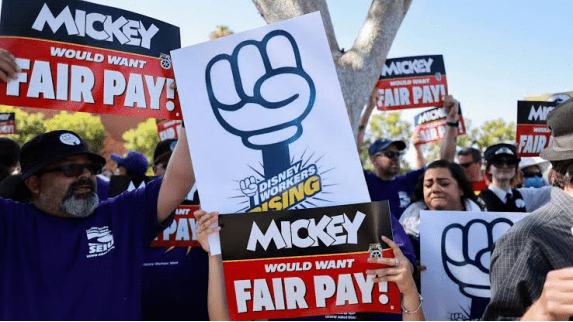
Disneyland Workers Face Housing Crisis and Low Wages as Union Protest Intensifies
Fiona Nanna, ForeMedia News
7 minutes read. Updated 12:03AM GMT Sun, 21July, 2024
Workers at Disneyland, renowned globally as the “Happiest Place on Earth,” are confronting severe financial challenges, including homelessness, as they grapple with low wages. Cynthia “Cyn” Carranza, an overnight custodian at the park, has shared her distressing story, revealing the harsh realities faced by many of Disneyland’s employees.
Carranza, who earns $20.65 an hour (approximately £15.99), found it impossible to cover the cost of rent in Southern California, where the average apartment price exceeds $2,000 a month (around £1,550). Last summer, she was forced to live in her car with her two dogs, a struggle compounded by the necessity of sleeping during the day. “That’s not something that anybody should experience working a full-time job for a company like Disney,” Carranza told the BBC. Her situation worsened as she resorted to sneaking into Disneyland’s costume department for showers. Despite now sharing a small apartment with her boyfriend—also a Disney employee—the couple barely manages to make ends meet.
The financial strain on Disneyland employees is part of a broader issue affecting approximately 10,000 union workers. These workers are on the brink of striking over low wages and alleged retaliatory anti-union practices. A recent vote, which saw an overwhelming majority authorize strike action, sets the stage for potential industrial action if contract negotiations falter.
Union officials report that about 10% of Disneyland’s cast members have experienced homelessness. A survey conducted among employees reveals that 73% struggle to meet basic monthly expenses, and approximately one-third have faced housing insecurity in the past year. “We’re the ones who make the magic,” said L Slaughter, a host at the park’s Toontown area. Slaughter, who spent two years living in her car while working at Disneyland, now resides in a small apartment about an hour’s drive from the park. However, the rising cost of living remains a significant challenge. “My rent just went up $200, and I won’t be able to make rent again,” she lamented. Despite earning $19.90 an hour—thanks to a minimum wage increase mandated by city voters in 2018—Slaughter finds it difficult to cope with the high cost of living in Southern California.
A living wage calculator developed by the Massachusetts Institute of Technology (MIT) indicates that a single person in Orange County, where Disneyland is situated, would need to earn $30.48 an hour to cover basic living expenses. This figure underscores the inadequacy of current wages for Disneyland employees, who find themselves struggling despite their dedication to the Disney brand.
Many Disneyland workers continue their employment at the park due to their deep-seated affection for Disney and the benefits provided, such as healthcare and access to a union-operated food bank. However, the labor dispute has intensified due to allegations of retaliatory actions against union members. In June, unions filed unfair labor practice charges with the National Labor Relations Board against Disney, accusing the company of intimidating workers and unlawfully disciplining those who wore union badges.
Veteran employee Colleen Palmer, who has worked at Disneyland for nearly 37 years and earns close to $24 an hour, highlighted the stark disparity between worker wages and Disney executives’ compensation. Disney CEO Bob Iger’s 2023 salary of $31.6 million contrasts sharply with the modest earnings of park employees. Palmer argues that the pay gap is unjust, given the significant role workers play in Disney’s financial success. “It makes me wonder, why don’t you want to recognize me? Because I’m making you that money, so that you can buy that sports team now,” she said, referring to Iger’s recent acquisition of the LA women’s soccer team, Angel City Football Club.
The disparity in compensation between workers and management has fueled labor unrest in the United States. According to the Economic Policy Institute, CEO compensation surged by 1,460% from 1978 to 2021, exacerbating the sense of inequity among employees.
Disneyland is more than just a job for many employees; it is considered a career, with workers often being passionate fans of the Disney brand. While perks like free admission to Disney parks for family and friends are attractive, employees report that Disney is inflexible in accommodating family crises or sickness. Many workers juggle multiple jobs due to Disneyland’s unpredictable schedules, making it challenging to maintain a work-life balance.
For students and retirees working part-time, Disneyland might still be a desirable workplace, but full-time employees argue that it no longer provides a living wage in Anaheim, a wealthy city where Disney is the largest employer. “Without us, Disney would be like anywhere else,” said Morgan, who lived in motels around Disneyland for four years with his children. Morgan, who requested to be identified only by his middle name, faced financial hardship after his marriage ended, leading him to sleep outside and hide from police or theft. He now has a second full-time job as a recruiter and an apartment he can afford with his combined income. Despite this, he remains proud of his role at Disneyland and believes that employees deserve fair compensation for their contributions. “It’s not the animatronics—it’s us. At least respect us enough to pay us a decent wage.”
The current labor dispute echoes a broader trend of workers demanding fair compensation amidst rising living costs and increasing income inequality. As contract negotiations resume on 22 July, Disneyland employees hope for a resolution that will address their economic concerns and secure fair wages.

